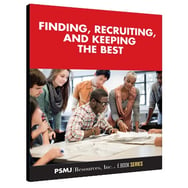.jpg?width=285&name=images%20(5).jpg) Suppose you’ve been asked to undertake a personnel search. What’s your first task?
Suppose you’ve been asked to undertake a personnel search. What’s your first task?
The answer: Determine whether you actually need to add a person to the firm.
Are there other alternatives available to fill the vacant position? How do you know whether or not your architecture or engineering firm needs a new employee? Ask yourself the following:
1. Consider current utilization rates:
-
What have your utilization rates been for those in the department, branch, team or group?
-
Do you have established utilization targets for production units?
-
If not – why not?
-
If current utilization levels are not at targeted levels in the recent past, why would you need to hire someone new?
2. Of what duration is your need?
If it is short, you might be better served to look for a temporary fill from inside you company or from a temporary employment company.
3. Have you looked elsewhere in your company for interested and/or available personnel?
Firms that hire too quickly often find themselves in a position to layoff soon after hiring. This can lead to substantial increases in unemployment tax rates, which can eat up profit margins very quickly.
4. What is the cost of not filling a position?
Ask yourself if the projects requiring additional personnel are really in the company’s best interest, or if you are building staff to support projects that are of marginal interest to the overall profitability of the firm.
5. Can you work your existing staff overtime to meet the immediate demand at hand?
6. Does the manager have someone in particular in mind?
7. By hiring a person, would you be violating company rules of nepotism, re-hiring a former employee, etc.?
8. Are market conditions and work projections such that you are convinced there is a need to load up on personnel?
Hiring additional staff is expensive and time consuming. Don’t do it for a project that requires additional assistance for two to six months only. You’ll find that the return is far more expensive than is warranted. Studies show that at the very least, it takes six months for new employees to really hit their stride in the company.
 For more human resources and hiring tips, check out PSMJ's free ebook Finding, Recruiting, and Keeping the Best, which provides advice from the A/E/C industry’s most successful, forward-thinking HRs leaders on how to grow—your people, your leaders, and your business—in this global economy.
For more human resources and hiring tips, check out PSMJ's free ebook Finding, Recruiting, and Keeping the Best, which provides advice from the A/E/C industry’s most successful, forward-thinking HRs leaders on how to grow—your people, your leaders, and your business—in this global economy.
You also might be interested in these HR-related blog posts:
8 Links That Will Make You a Better HR Professional
Lead through Powerful Interviewing Techniques
Are Your Employees Engaged, Or Just Satisfied?



